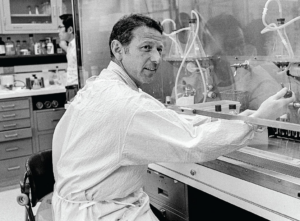May 12th, 2023
Started in February 2020, the SAJO blog is providing information about pandemics, pathogens, infectious diseases and further important topics.
You may zoom in and out using CTRL+ and CTRL-
Dear readers,
Why mention both, Paul Berg and Artificial Intelligence, in one single post? We’ll come to this question a bit later.
In March 2023, one of the founding fathers of modern molecular biology, Paul Berg, passed away. He was famous for more than his Nobel Prize of 1980. His long-time colleague David Baltimore (who in 1975 won a Nobel prize together with Howard Temin and Renato Dulbecco) wrote an obituary for Science covering some of his most important work (1) as father of genetic engineering.

Paul Berg was aware of the fact that new technologies do need to be accompanied by a watchful society to avoid its use in risky areas.
The advent of molecular biology came as a bombshell. Its immense possibilities were seen immediately by the people involved. One of them was Paul Berg. He and others organized a meeting that now is famous. In 1975, scientists met at the Asilomar Conference Center in Monterey, California. Their goal was to identify and hedge possible risks of this new technology. In the end, they petitioned with the US government for regulation of genetic engineering. This policy was further adopted by many countries worldwide. Nowadays, genetic engineering is in use worldwide, and its risks have been hedged successfully.
As with any new groundbreaking technology, genetic engineering had the potential to its being used either for good or bad. Just as with nuclear fission: You may provide mankind with clean energy or with an atomic bomb. For genetic engineering, the prospects of medical breakthroughs or agricultural revolution were clearly at hand, as was its use to tinker with human genetics.
Without genetic engineering, today millions of diabetics would still have to inject pig insulin with all the terrible side effects, instead of the human hormone (produced by a genetically modified organism, GMO). However, while there are examples of good use of GMOs, there are some downsides as well. A prime example would be Monsanto (now a Bayer subsidiary), a company that used this technology to make their crops resistant to their own herbicide (Roundup) which now is used in copious amounts instead of reducing its use. All for company profit.
One thing that was banned outright from the beginning, is human germline modification, when a modification is inherited to the newborn child. But even illegalizing this did not prevent a researcher in China from doing it anyway.
This is the reason why it is important that governments regulate new technologies before companies can establish a monopoly. Now, this brings us to the link we mentioned above between Paul Berg – one father of molecular biology – and artificial intelligence.
Today, artificial intelligence (AI) is revolutionizing the economic world. While we see many positive aspects of its use, there are also critical or dangerous applications.
Some positive aspects are found in science, medicine, technology, and many other aspects of daily life. In medicine, AI does already (and will in future much more) help in diagnosing rare diseases or provide image analysis before surgery or the identification of tumors or strokes for example, as well as assisting in surgery. This, with time will lead to autonomous systems performing surgery on their own. AI is used to scan huge data collections, and to screen the internet. In science it also may be used for fast data assessment, but also for the identification of fraud in publications. These are all useful applications of AI in science and medicine. One very recent example is the use of AI to improve vaccines (2) and antibodies (3).
Agriculture is using AI for the most efficient way to seed, fertilize, water, and harvest plants. It has huge potential in household and care. AI is exceptionally good at learning, at learning very fast. There are reports of robots making use of an instruction manual to set up furniture. It started with simple IKEA shelves, but the sky is the limit.
AI is used in many aspects of daily life already. Online texts for advertisements are an obvious place to look at. But increasingly, there are even textbooks written in part by an AI. Customer service, be it online or by phone is in many cases driven by AI. AI may be used for all repetitive office tasks. This means there will be millions of layoffs in the near future. IBM already has started to replace staff by AI in their offices. Companies such as Amazon, Otto Group, and Zalando announced they will replace personnel by autonomous robotic systems that are collecting, packaging, wrapping, and sending orders. Many other companies will follow. A majority of companies have one major objective, making profit no matter what.
Nowadays, most of the development of AI is being done in companies, not in the public research sector. Shareholder value dictates the development. Ethical considerations are not really important here: Microsoft recently cut its ethics and society team (4).
Where is the ethics in trying to read a human mind (5)? AI is able to identify an individual’s face, read their lips, and probably even body language. There is no need for fMRI (functional magnetic resonance imaging) reads to find out a person’s intentions.
The advantages of employing AI are obvious. It does work very diligently, does not need breaks or vacation. It needs no motivation or payment, while working steadily with constant improvement. Thus, many jobs will be lost to AI, starting with simple but repetitive tasks now, and leading to more and more autonomous systems dealing with more and more sophisticated tasks. Filing taxes, writing legal texts or patent applications, supporting attorneys in finding the best way to sue or to defend, are just a tiny fraction of what is thinkable.
The consequences will be layoffs not just in industry but in all economic sectors. This poses an imminent problem. Since AI does not earn wages, there is no income tax. Since income tax is a major contributor to a government’s budget (in Germany it accounts for 25 % of all taxes) this will have a major effect. In the long run, AI must be taxed, to make up for the lost tax, supporting the unemployed, and the financing of a four-day week (which is becoming very popular already right now).
One aspect we have avoided to discuss in this post is the military use of AI. In fact, the military will make good use of such a “soldier”. Warfare does not just happen on the battlefield. Using AI to weaken a foreign country is only one aspect.
What is already being done is manipulation of news and media and voters’ decisions. This does not just include fake news outlets: It won’t take long, and AI generated “photographs” will no longer be distinguishable from real pictures. We are merely seeing the beginning of this development.
This development is growing at full throttle. We had dealt with exponential growth in previous posts on infectious diseases. This is happening now with AI. It is learning.
When will systems be online that learn to learn by asking questions or formulating their own objectives? When will fully autonomous systems be available? How do you stop an immensely fast learning and acting system from intruding into systems up to now only the most skilled hacker teams may enter?
AI will find its own way to surmount digital defenses and firewalls, compromising infrastructure and security. Does this sound like science fiction? We should not wait and see.
Now is the time for all the experts to congregate and to find a common way to hedge the technology, to make use of its advantages and to stop dangerous developments. This is what took place in the 1970s at the Asilomar Conference on genetic engineering. It is high time that the developers and specialists in the AI field are voicing their criticism and warnings. Where are the expert voices warning of dangerous developments, while pushing the positive aspects? So far only a scant few have started to do this. Among them are people from quite different fields of interest.
Just a week ago one of the major driving forces in developing AI, Geoffrey Hinton spoke up (6). And, a surprising ally, Warren Buffett also gave a dire warning, as may be seen in major news outlets.
A number of tech entrepreneurs have signed an open letter calling for a six-month moratorium on AI development (7). Unfortunately, such a voluntary moratorium most likely will not work, since the competition among the players involved will give those an advantage who do not take part in a moratorium. This would need government involvement. Only enforceable laws will have an impact on this development.
Why did this work for genetic engineering, but not for AI development? We suspect it is the place where the inventions and first developments took place. In the 1970s this took place at universities and public research institutions. These people were deeply involved in the revolutionary technology. There was such a thing as research ethics in the public sector. For a company developing AI systems this is irrelevant.
Regulation must make sure that all the bad uses of AI are kept at bay while not stopping all the good things AI may provide. Hence, there is a need for scientists involved in AI development to get together and make suggestions to the policy makers that prevent problematic developments and at the same time offer a framework for its positive use. This in itself is not easy, but it is the urgency that makes this task extremely difficult.
AI is evolving at a scary pace. If for the better or the worse is in the hands of the developers, the science, and the politics. Pandora’s box is open. All we can do now is hedge the demons.
A good start would be a mandatory AI label. Any food produced using genetic engineering is being labeled for the customers to decide if they want to buy it. Why not use such a labelling for AI as well?
It will be challenging to regulate a self-learning, autonomous system, which might develop its own tasks and goals. What power and influence do we want to give an AI system?
Voter manipulation is just one rather simple aspect. The sheer bombardment in social media with half-truths and fake news already takes its toll on people’s reasoning. An AI system assigned to find ways to fight climate change might come to the (correct) assumption that the biggest threat to Earth’s ecosystem is us. What if AI is turning on us?
It is high time to make a political and legal framework, that ensures the best use of AI while preventing its pitfalls. In fact, this should not have started yesterday, but the day before.
Let’s hope “better late than never” will not be proven wrong tomorrow.
Original literature (1-7) used in this article, here you may find the links: (1) https://www.science.org/doi/10.1126/science.adh2943 (2) https://www.nature.com/articles/d41586-023-01487-y (3) https://www.nature.com/articles/d41586-023-01516-w (4) https://www.washingtonpost.com/technology/2023/03/30/tech-companies-cut-ai-ethics/ (5) https://www.nature.com/articles/d41586-023-01486-z (6) https://www.bbc.com/news/world-us-canada-65452940 (7) https://www.science.org/content/article/alarmed-tech-leaders-call-ai-research-pause
Yours, Joerg and Sabine

Dr. Sabine Breun and Dr. Joerg Baumann, both Ph.D.s, virologists, immunologists, molecular biologists and founders of SAJO. Both are specialized in infectious diseases. Since the 90s, Dr. Baumann has been working on zoonoses and how pathogens overcome the species barrier. Since 2000, Dr. Breun works on the interaction of viruses with the immune system. Both work as team. SAJO enables new antivirals – antivirals of the next generation to fight pandemics.
During their scientific carreers, both performed scientific work for 5 years at the National Cancer Institute in a US elite program on competitive US scholarships.


SAJO – for a healthy and better future!
SAJO is consulting all around infectious diseases. We are applying our know-how, that we have acquired in more than 20 years. We do what we can to fight this pandemic.


This is post No. 252. To our delight our blog is receiving a lot of readers, we love to share our know-how and expertise. Please feel free to share the link – it is an informative tool to fight this pandemic and upcoming threats.
(Note: We are no members of political parties, religious congregations, or societies. We value independence, sovereignty, and freedom. With our blog we are providing purely scientific advice, without conflict of interest, altruistic. We are not being paid for it.)

The SAJO high technology (the heart of SAJO) allows for the identification and isolation of next generation antiviral and antibacterial components for the development of new drugs, for prevention or therapy. This is what we do best – these are our USP and our strength.
#1 We want to treat, cure and prevent infectious diseases with new therapeutic drugs. Calls for investments and financing are open. If you aim at the same goal, then please get into contact with us.
#2 Should you like to have SAJO antivirals or antibacterials, or to give a contract, or need consultation, or to invest into SAJO, please do not hesitate to contact us. You may use the form on our homepage or phone number or email. We are looking forward to talking to you.
The SAJO business model: https://www.sajo-innovation.de/sajo-Flyer.pdf
Visit Sabine at XING https://www.xing.com/profile/Sabine_Breun and Jörg at LinkedIn https://de.linkedin.com/in/j%C3%B6rg-baumann-phd-0710b11a3


